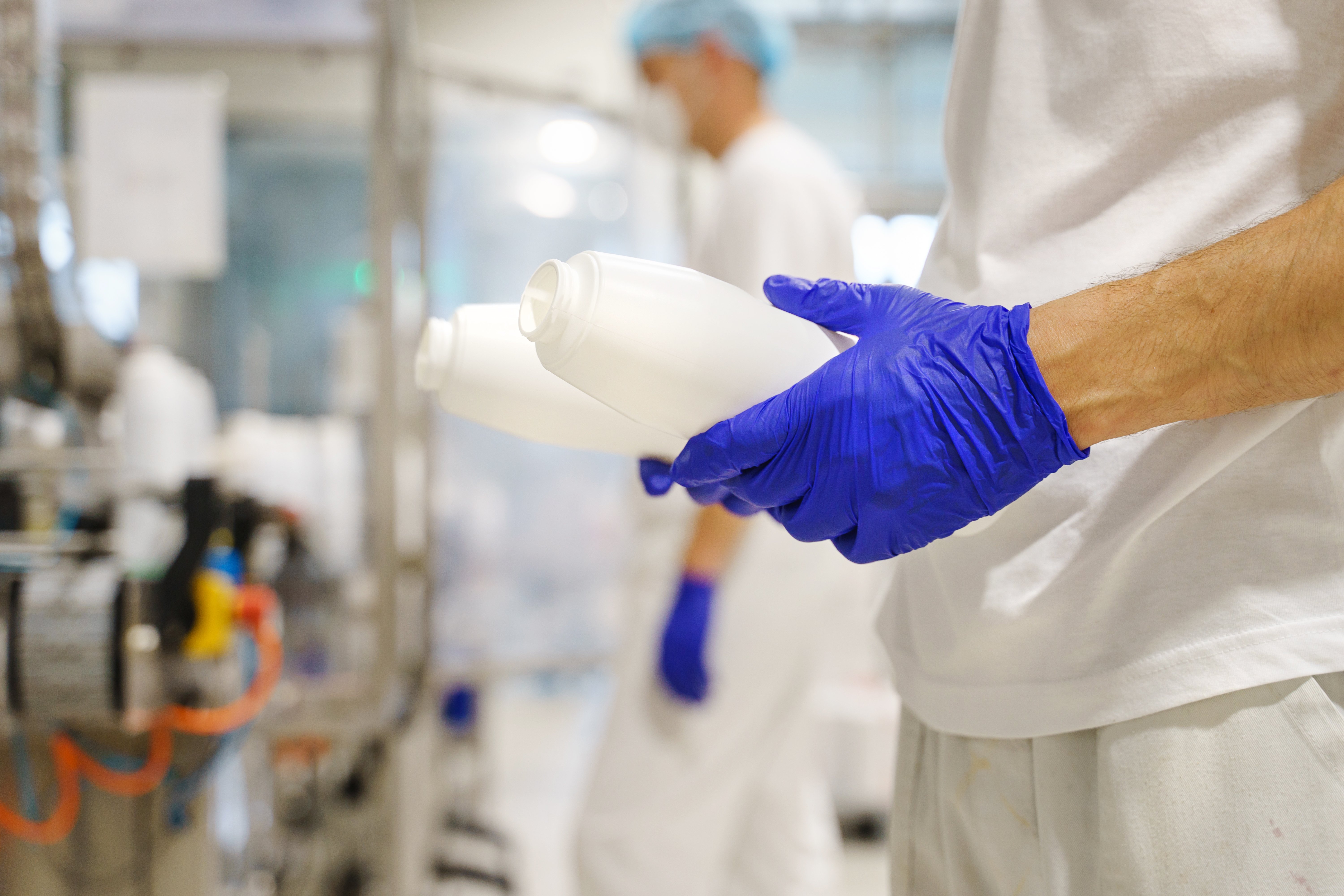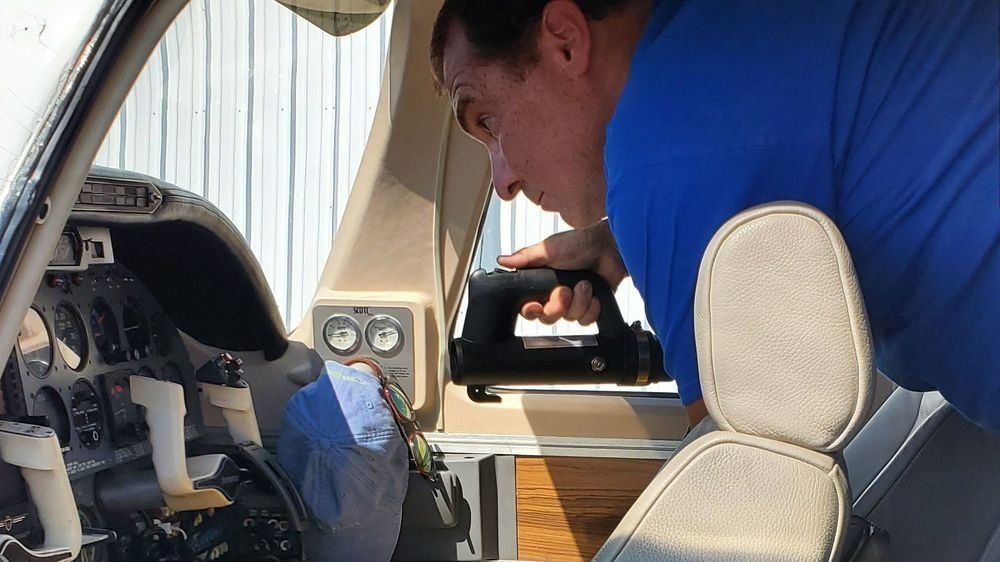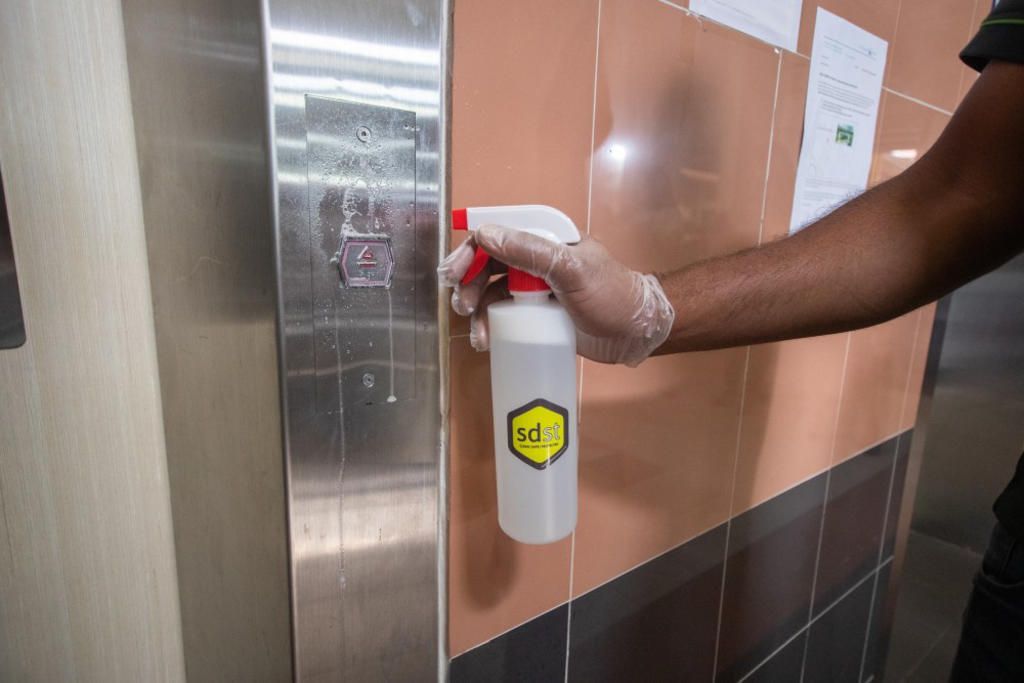DS Blog

There has been a longtime mystery for the so called “invisible barrier” left behind resisting microbial growth on surfaces treated with Decon7. These surfaces or substrates include but not limited to the following; Carpet, clothing, brick, vinyl (fences, siding, curtains – poultry barns), cement, stucco, all wood for construction, HVAC ducting, evaporator coil pans, sheetrock, filter material, etc. Unlocking the mystery has been quite puzzling and from recent lab testing done some discoveries have taken place to explain this chemical reaction; Firstly the Part I formulation has an extensive ingredient list (proprietary), and there is one ingredient that has decomposition properties. Secondly the Part II is mainly H2O2 – 7.9% Hydrogen Peroxide which has penetration and oxidation properties. When the 2 parts come together they create a completely different action than if they were applied separately. Part I has decomposition capabilities within the main ingredients, this decomposition action begins to take place from the Part II joining. The reactivity and “dwell” time of the 2 formulations mixed eventually breaks each formulation down to the so called “barrier”. During this “dwell” time the 2 parts are capable of penetrating spore walls and destroying the mycotoxins or cytotoxins within the spore. Because of this it becomes extremely effective when used in a fog application. The fog or mist is atomized to a small enough micron to hang in an air space long enough to degrade and destroy any airborne spore or surface mold spore or colony. The so called “barrier” is the resulting chemical reaction of the 2 components degrading each other to the point of making a “hardened” surface, mostly of an Alkali and peroxycarbonate. A portion of the alkali (carbonate) rearranges in such a manner to form a water insoluble compound. This compound “barrier” creates an alkaline surface with a pH high enough - (pH of over 8), to deter and inhibit growth of microorganisms. This resulting barrier would also be able to be classified as a “green” final composition given the decomposition of most initial ingredients. And the so called “residue” left behind would be classified as a mined substance. The benefit of such an “invisible barrier” would be the fact that it would be completely non-toxic, extremely resistant to microorganism growth, mold and algae. The real benefit is while the 2 parts are active (8 to 12 hours) it becomes deadly to any spore, bacteria, virus or microorganism. And having this product also capable of creating a “zone of inhibition” it really becomes a standalone 2 part formulation unlike anything on the market. Treating substrates such as sheetrock paper, plastics, vinyl, or even air filtration material become reality, and now to claim not necessarily killing microorganisms, but creating a barrier that is resistant for any growth and is water insoluble is quite remarkable. Decontamination and cleaning test sites on roofs, decks, siding, (vinyl & stucco) have been ongoing for up to 4 years. Also remodel projects with moisture intrusions creating mold issues have been conducted. There has been no recorded re growth of any mold or algae on any surfaces treated with the Decon7 formulations. Mold remediation in homes and commercial properties using Decon7 is in the hundreds of thousands of square footage treated by the fogging and spraying method. Industrial Hygienists have been engaged for testing spore activity before and after, resulting tests have indicated the non-viable spore counts to be near zero on most sites. The residue is nontoxic, nonflammable and completely environmentally safe. With comparisons being made daily to all other products on the market – there has not been one that can claim these safety standards and perform even close to our Decon7 line of products. 長期以來,人們一直對所謂的“看不見的屏障”感到困惑,因為3D處理的表面上屏障微生物無法抵抗及生長。 這些表面包括但不限於以下; 地毯,衣服,磚,乙烯樹脂(柵欄,壁板,窗簾-家禽舍),水泥,灰泥,所有建築用木材,HVAC管道,蒸發器盤,薄板岩,過濾材料等。 最近的實驗室測試做了一些發現,可以解釋這種化學反應。 首先,Part1具有豐富的成份具有分解獨特性。 其次,Part2主要是H2O2-7.9%的過氧化氫,具有滲透和氧化性能。 當兩個部分放在一起時,它們將產生與單獨應用時完全不同的動作。 Part1在主要成分內具有分解能力,這種分解作用從Part1的加入開始發生。 混合的兩種製劑的反應性和“停留”時間最終使每種製劑分解成所謂的“屏障”。 在此“停留”時間內,這兩個部分能夠穿透孢子壁並破壞孢子內的真菌毒素或細胞毒素。 因此,當用於霧化應用時,它變得極為有效。 霧或霧被霧化到足夠小的微米程度,以在空氣空間中懸掛足夠長的時間,以降解並破壞任何空氣傳播的孢子或表面黴菌孢子或菌落。 所謂的“屏障”是兩種組分相互降解到最終形成“硬化”表面的化學反應,主要是鹼和過氧碳酸鹽。 這種化合物“屏障”可形成鹼性表面,其pH值足夠高(pH值超過8),可以阻止和抑制微生物的生長。 考慮到大多數初始成分的分解,由此產生的屏障也可以歸類為“綠色”最終組成。 留下的所謂“殘渣”將被歸類為礦物質。這種“隱形屏障”的好處是它完全無毒,對微生物的生長,黴菌和藻類具有極強的抵抗力。 真正的好處是,當這兩個部分都處於活動狀態(8到12小時)時,它對任何孢子,細菌,病毒或微生物都具有致命性。 而且,由於該產品還能夠產生“抑制區域”,因此它實際上成為了獨立的兩部分配方,與市場上的任何產品都不一樣。 處理諸如薄岩紙,塑料,乙烯基或什至是空氣過濾材料之類的基質已成為現實,現在聲稱不必殺死微生物,但創造出一種對任何生長都具有抵抗力且不溶於水的屏障,這是非常顯著的。 屋頂,甲板,壁板(乙烯基和灰泥)的去污和清潔測試場地已經進行了長達4年。 還進行了帶有潮氣侵入而導致發霉的重塑項目。 在用3D配方處理過的任何表面上,沒有任何黴菌或藻類再生的記錄。 使用3D對房屋和商業物業中的黴菌進行修復的方法,是通過霧化和噴塗方法處理的數十萬平方英尺。 工業衛生學家之前和之後都參與了孢子活性測試,結果表明大多數地方的無效孢子數都接近於零。 殘留物無毒,不易燃且完全環保。 每天都與市場上的所有其他產品進行比較-尚無一種產品可以聲稱有這些安全標準,甚至可以接近3D這類產品。

Decon7 has been working hard to expand production in response to increased global demand for disinfectants due to the coronavirus pandemic. In addition to adding six new production facilities, we have also become kosher- and Halal-certified, allowing us to distribute products in even more countries.

The global pandemic has caused disinfectant manufacturers to scramble to get EPA-approved label claims, and it’s not surprising that many companies have seen a dramatic increase in production. Manufacturing of D7 is no exception. Before the pandemic, D7 was produced in two facilities. Because demand has increased significantly, it is now made in eight different locations.

As the global pandemic continues, many businesses are pivoting. Garment manufacturers are making face masks, distilleries are making hand sanitizer, and restaurants are finding new and creative ways to stay afloat with limitations on how they are allowed to operate. With a product that kills viruses at the RNA level, Decon7 was already well positioned to expand operations in order to meet the increased demand for disinfectants and hand sanitizers.

Firefighting is dangerous for obvious reasons, but one of the less obvious risks is exposure to harmful carcinogens. Decontamination on the Fireground of turnout gear and equipment is critical for protecting firefighting professionals from unnecessary exposure to dangerous chemicals. Because of this, turnout gear decontamination should be part of regular training to the extent that it becomes second nature.

The global pandemic has caused a dramatic increase in the use of chemical disinfectants and unfortunately, some of these include claims of residual efficacy against viruses. Many of these claims are false, and although EPA will pursue false claims, it can take time. In the meantime, it’s up to consumers and commercial disinfectant users to educate themselves about potentially false claims.

LEWISTON, Ida — In order to protect the safety of travelers and employees, the Lewiston Nez Perce county regional airport has been spraying common areas with a chemical solution called Decon7. I-Wash Aircraft Detailing, a company headquartered out of the airport, has been sanitizing the airport daily since August 27th. Decon7 is a deodorized, colorless surface sanitizer, proven to eradicate COVID-19. "Decon7 has a kill log of 99.9999 percent," said Cory Krolfifer of I-Wash Aircraft detailing. It's also completely safe for people to be around, allowing the disinfectant to be deployed during airport hours without any risk to the public. The focus is high-touch areas such as the kiosks, seating, restrooms, and carpet. "We feel it’s important not to leave anything out,” Krolfifer said. “Pretty much anywhere where it’s a hand contact surface or where it can be harbored." I-Wash disinfects the airport terminal three times a day, and sprays down the administration building once a week. They also offer their services to the interiors of planes coming in and out of the airport. Right now, Decon7 is setting the standard for airports throughout the country. "lax, Chicago, some of the bigger airports have used this chemical and its really good for fogging big areas," Airport Director Mike Isaacs said, adding that LWS is one of the first airports in our region to use the disinfectant. The airport has already added UV lights and air purifiers to the hangers. Delta airlines has a been sanitizing every incoming flight "We're trying to get people to feel comfortable about coming into the airport," Isaacs said. Now, for what Isaacs calls a very reasonable price to the airport, Decon7 is one more thing that can help travelers and employees feel safe. "it comes down to customer confidence...now we are restoring... We're starting to come up on the other side of it," Isaacs said. For more information, please refer to https://klewtv.com/news/local/lewiston-airport-deploys-disinfectant-that-kills-covid-19

Chemical disinfection and inactivation of viruses is largely understudied, but is very important especially in the case of highly infectious viruses. The efficacy of the Sandia National Laboratories developed decontamination formulations (DF-200D) against Bovine Coronavirus (BCV) as a surrogate for the coronavirus that causes Severe Acute Respiratory Syndrome (SARS) in humans. For this study, preliminary testing with Escherichia coli MS-2 (MS-2) and Escherichia coli T4 (T4) bacteriophages was conducted to develop virucidal methodology for verifying the inactivation after treatment with the test formulations following AOAC germicidal methodologies. After the determination of various experimental parameters (i.e. exposure, concentration) of the formulations, final testing was conducted on BCV. All experiments were conducted with various organic challenges (horse serum, bovine feces, compost) for results that more accurately represent field use condition. The MS-2 and T4 were slightly more resistant than BCV and required a 2 minutes exposure while BCV was completely inactivated after a 1 minute exposure. These results were also consistent for the testing conducted in the presence of the various organic challenges indicating that the test formulations are highly effective for real world application. In general, virucidal activity and mechanism of action of various disinfectants is largely understudied. Standards for virucidal testing are being developed, however none are mandated at this time for verifying virus inactivation. It is largely accepted and recommended to follow Association of Official Analytical Chemists (AOAC) germicidal methods for virucidal efficacy testing. The major structural targets of disinfectants against viruses include the viral envelope (predominantly lipid), the capsid (predominantly protein), and the genome (nucleic acid material). According to the Klein-DeForest Scheme, mechanism of action of various chemical disinfectants against viruses is largely due to the presence or absence of a viral envelope, with the latter typically being more resistant. Viruses are typically categorized into: -Groups A (lipophilic with envelope) viruses, -Groups B (hydrophilic, non-enveloped) viruses, or -Groups C (intermediate solubility, nonenveloped) viruses The structural target on the virus is dependent on the type of disinfectant used. Because coronaviruses are an enveloped virion, they fall into the Klein-DeForest susceptibility group A. Group A is susceptible to compounds including halogens, aldehydes, Quaternary Ammonium Compounds (QAC), phenolics, alcohols, peroxide, proteases, and detergents. It is important to note that the susceptibility is referring to the ability of the disinfectant to disrupt surface properties typically important in attachment to cellular receptors, and does not always result in complete degradation and loss of replication functionality of the nucleic acid. In this research, BCV was used as a surrogate for the virus that causes SARS to study inactivation. Since there are few published protocols for determining virucidal activity of disinfectants, it was important to develop methodology in which exposure duration could be controlled by neutralizing, or quenching, the antiviral effects. Due to the necessity of an in vitro cell culture for propagation of BCV, the subsequent removal of the toxicity due to the nature of the chemicals present in the test formulations was necessary to conduct the virucidal efficacy tests. Disinfectant activity is often reduced in the presence of organic materials due to cross reactivity with compounds in the organic load effectiveness. In order to be representative of environmental conditions, the test formulations were also challenged in the presence of organic material including horse serum (for MS-2 and T4) or bovine feces and compost (for BCV). Sandia National Laboratories test decontamination formulations to inactivate SARS coronavirus by using a close relative, BCV that would react similarly. The results indicate that the test formulation (DF-200) were all highly effect in complete BCV inactivation in contact times as low as 1 minute even in the presence of various organic challenges. It is important to note that the term complete inactivation indicates the failure to recover the test virus, due to an inability to detect the last infective virus particle. The loss of infectivity of the treated viruses is a result of the disruption of important structures on the surface (namely the viral receptor cites) that physically prevent successful attachment and subsequent penetration intothe host cell. Because standard and official methods or protocols do not currently exist for testing disinfectants as virucides, factors including time of contact, organic load, tissue culture system, sterility, and temperature were all carefully controlled and monitored in this research. Refer by Rapid Inactivation of SARS-like Coronaviruses Report, Sandia National Laboratories, operated for the United States Department of Energy by Sandia Corporation.

BEIJING (Reuters) - U.S. manufacturer Decon7 Systems is stepping up production of a powerful disinfectant at six facilities, from three, to fill surging demand from hospitals in China grappling with a virus epidemic, the firm’s founder, Joe Drake, told Reuters on Monday. As hospitals in the central province of Hubei and neighboring regions struggle to rein in a new coronavirus that has killed 361 people and infected more than 17,000, demand has swelled during the last fortnight. “This is off the charts,” Drake said by telephone. “They want everything we can manufacture.” China has repeatedly said it is short of key medical supplies in the worst-hit areas, including basic gear to protect medical workers, such as face masks and protective suits. With hospitals in the cities of Wuhan, Jingzhou, Xiaogan and Changde all requesting disinfectant, Decon 7 will run double shifts at three new facilities in the United States from this week, in addition to three sites already in operation, Drake added. The company hopes to air freight seven containers of product, each containing 80,000 pounds, or about 36 tonnes, this week to hasten delivery that normally takes three to four weeks by sea, he said. “It’s not hard to make the product, but it’s the packaging,” Drake added. “They want it in small sizes, which are easier for staff to handle.” The Scottsdale, Arizona company, which supplies major food processors and poultry farms in the United States, started shipping its hydrogen peroxide-based product to China last year to decontaminate farms infected with deadly African swine fever. On Saturday, Beijing waived a duty of 48% it has levied on the product because of its trade war with the United States, with the finance ministry saying it had implemented a temporary exemption on U.S. products aimed to help curb the outbreak. The disinfectant, known as D7, works by attacking viruses and killing the virus RNA. Effective for up to 8 hours in a wide range of temperatures, it is being sprayed in hospital areas where virus patients have been treated, in order to kill particles left on surfaces, equipment or in ventilation systems, Drake said. Large slaughterhouses and industrial farms typically buy the product in multi-gallon drums. The southeast Asian city-state of Singapore has also asked for a price quote for 1 million face masks and 1 million bottles of hand sanitizer, Drake added. With its manufacturing operations in the United States, the firm has escaped the production woes facing mask makers in China. Reporting by Dominique Patton; Editing by Clarence Fernande


